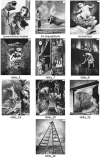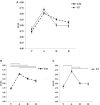Bizarreness and Emotion Identification in Grete Stern Photomontages: Gender and Age Disparities
- PMID: 28382010
- PMCID: PMC5360721
- DOI: 10.3389/fpsyg.2017.00414
Bizarreness and Emotion Identification in Grete Stern Photomontages: Gender and Age Disparities
Abstract
Although the International Affective Picture System (IAPS) is used to evaluate emotions (valence, arousal, and dominance evoked by a large set of photographs), bizarre images in works of art have not been assessed with the IAPS procedures. Understood here as strange, non-sense, and absurd mental contents or expressions accompanied by surprise and confusion emotions, bizarreness was assessed after healthy adult volunteers assigned this specified variable to 140 Grete Stern's photomontages overtly intended to illustrate strange, absurd, and non-sensical contents in dream reports. The images were presented to 21 Young Males (YM) and 30 Young Females (YF) who were instructed to use the IAPS Self-Assessment Manikin, along with an additional bizarre-to-normal scale, to evaluate their response to them. The valence and the bizarre-to-normal ratings showed a dissimilar pattern of distribution between genders. Ratings of scales were different, and a greater variation in scales occurred according to gender. When bizarreness was appraised, gender differences became more evident especially for YF, who rated half of the images as bizarre, and with a diminished feeling of control, while the neutral and normal images were deemed more pleased and controlled. Valence, bizarreness, and dominance formed a different component than arousal in both groups. Negative correlations between valence and dominance, and between valence and bizarreness were also found in both groups, plus a positive one for dominance and bizarreness in YF, along with curvilinear relationships among all scales. On a second experiment, 10 photomontages evaluated by YF as bizarre or as normal were administered to 18 Old Males (OM) and 28 Old Females (OF). OF's arousal showed less neutral evaluations than OM's. In OF the bizarre images evoked either more excitation or calmness than in OM. The distribution of the bizarre-to-normal scale was significantly different across the evaluations in YM, YF, OM, and OF. The use of this extended IAPS instrument to explore bizarreness and emotional variables in response to art images seems suitable and potentially valuable to characterize bizarre, absurd, or non-sensical mental states and their brain correlates.
Keywords: Grete Stern; age; art; bizarreness; emotion; gender.
Figures








Similar articles
-
Military Affective Picture System (MAPS): A new emotion-based stimuli set for assessing emotional processing in military populations.J Behav Ther Exp Psychiatry. 2016 Mar;50:152-61. doi: 10.1016/j.jbtep.2015.07.006. Epub 2015 Jul 21. J Behav Ther Exp Psychiatry. 2016. PMID: 26255051
-
The bizarreness effect: it's not surprising, it's complex.J Exp Psychol Learn Mem Cogn. 1995 Mar;21(2):422-435. doi: 10.1037//0278-7393.21.2.422. J Exp Psychol Learn Mem Cogn. 1995. PMID: 7738508
-
Positive erotic picture stimuli for emotion research in heterosexual females.Psychiatry Res. 2011 Dec 30;190(2-3):348-51. doi: 10.1016/j.psychres.2011.05.044. Epub 2011 Jun 21. Psychiatry Res. 2011. PMID: 21696831
-
How bizarre? A pluralist approach to dream content.Conscious Cogn. 2018 Jul;62:148-162. doi: 10.1016/j.concog.2018.03.009. Epub 2018 May 5. Conscious Cogn. 2018. PMID: 29739723 Review.
-
EmojiGrid: A 2D pictorial scale for cross-cultural emotion assessment of negatively and positively valenced food.Food Res Int. 2019 Jan;115:541-551. doi: 10.1016/j.foodres.2018.09.049. Epub 2018 Oct 3. Food Res Int. 2019. PMID: 30599977 Review.
References
-
- American Psychiatric Association (2014). Manual Diagnóstico y Estadístico de los Trastornos Mentales. DSM-V (Diagnostic and Statistical Manual of Mental Disorders (DSM-5)) España: Médica Panamericana.
-
- Cappuccio M., Froese T. (2014). Enactive Cognition at the Edge of Sense-Making. Making Sense of Nonsense. London: Palgrave Macmillan.
LinkOut - more resources
Full Text Sources
Other Literature Sources
Research Materials

